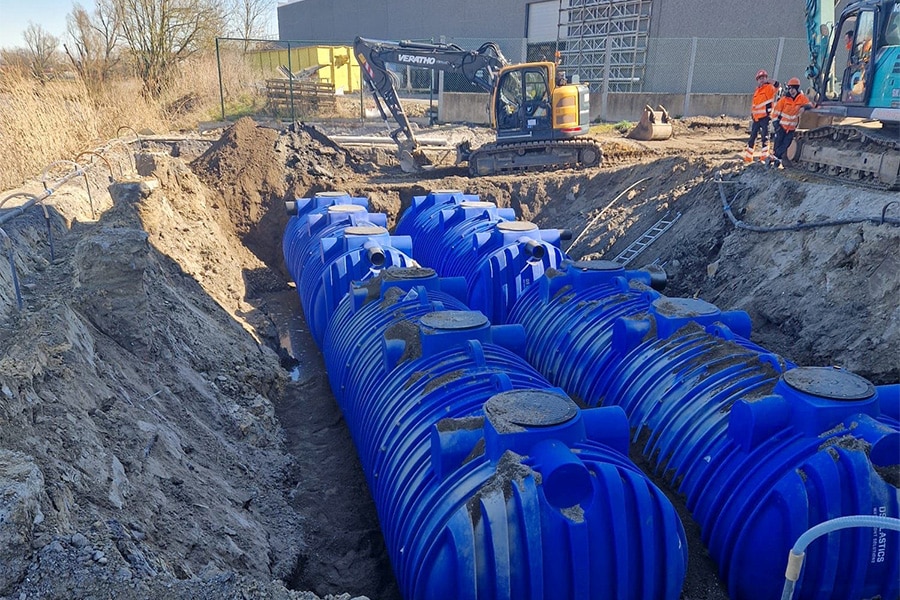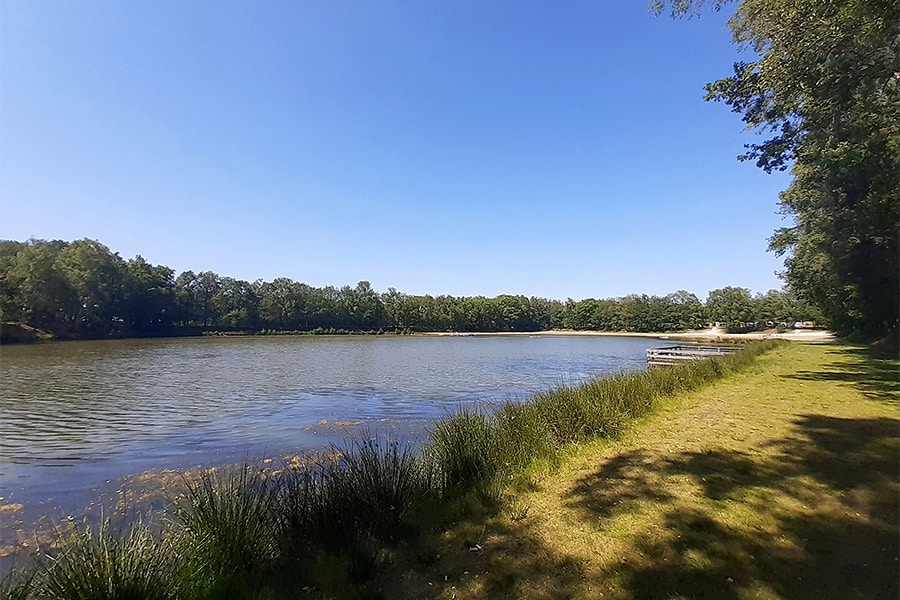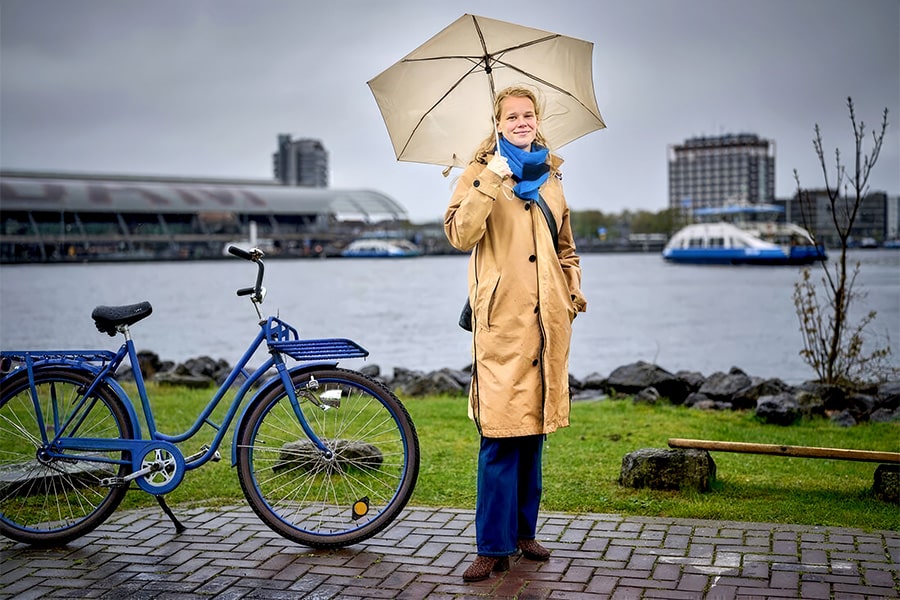
New floodgates protect hinterland of Afsluitdijk
To protect the floodgates of the Afsluitdijk and the hinterland from very high water levels and the force of the water, consortium Levvel (BAM, Van Oord and Rebel) is building two floodgates, also called storm surge barriers, on behalf of the Department of Waterways and Public Works. This is taking place both at Den Oever in North Holland and at Kornwerderzand in Friesland (on the Wadden Sea side). Under normal conditions, the floodgates will be open and at very high water levels, the floodgates will be closed and passage for ships will then be temporarily completely closed.
We talk to Jens Wijnants (BAM), work planner for Kornwerderzand flood lock and Johan Bentlage (Van Oord), implementer of Kornwerderzand flood lock and Coupure Vismigratierivier (VMR).

Jens Wijnants (BAM), work planner for Kornwerderzand floodgate.
Reduced disruption in all operations
"We started work on the floodgate in Den Oever two months ago," Wijnants opens the conversation. "Levvel is making both floodgates under the motto 'less hindrance'. Less disruption for road traffic, shipping and ecology. The placement of the sheet pile walls in the first phase is done from the water with as little disruption to shipping as possible. Our ships lie outside the waterway and, for example, no lifting takes place if a ship passes at that moment. Safety comes first and we make sure that ships can use both waterways for as long as possible. Once the sheet pile walls are in place we will backfill sand behind them to a dry situation, and then continue work from land."
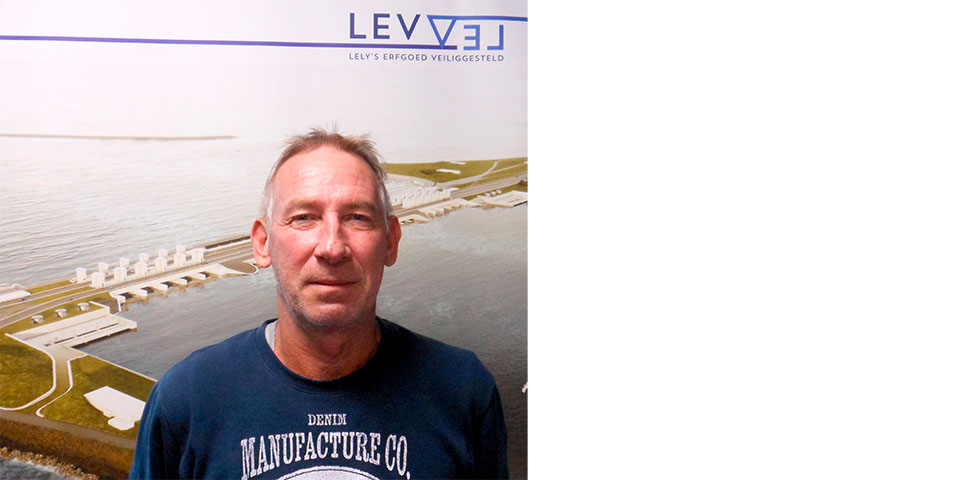
Johan Bentlage (Van Oord), executor keersluis Kornwerderzand and Coupure Vismigratierierier
Bentlage adds, "Temporary guide works are also being installed to prevent collisions with temporary construction pits and prevent damage to passing shipping." Work is currently still being done entirely from the water. "In total, we are talking about the deployment of a pontoon with an excavator on it for the dredging work, two wear barges for removal of the dredging material, a pontoon with a crawler crane for the jacking of the temporary cofferdams, a pontoon for the supply of the steel sheet piles and several tugs. There is also a survey boat sailing to measure the dredged depths," Bentlage lists. From the end of October, the waterway in Den Oever will have to be completely blocked for several months anyway. "Then the concrete work will be done," explains Wijnants. Shipping traffic can then divert via Kornwerderzand. At Kornwerderzand, by the way, we are now making the final preparations to start, expected to be at the end of the summer this year."
The floodgate at Den Oever
Bentlage: "The floodgate in Den Oever will be on the Wadden Sea side, in front of the lock. This flood lock will be equipped with so-called 'point doors', which we often see applied to locks. These lock doors are made of steel and driven by hydraulic cylinders. The point doors are closed at very high water levels, necessary to protect the lock and the hinterland from the force of the water. They thus function as storm surge barriers. Under normal weather conditions, they are open, allowing ships to pass through. It is expected that the floodgates will have to close a few times a year. Due to changing climate conditions and rising sea levels, we expect that this will have to happen more and more often in the future. At very high water levels, passage for ships will then be temporarily closed."
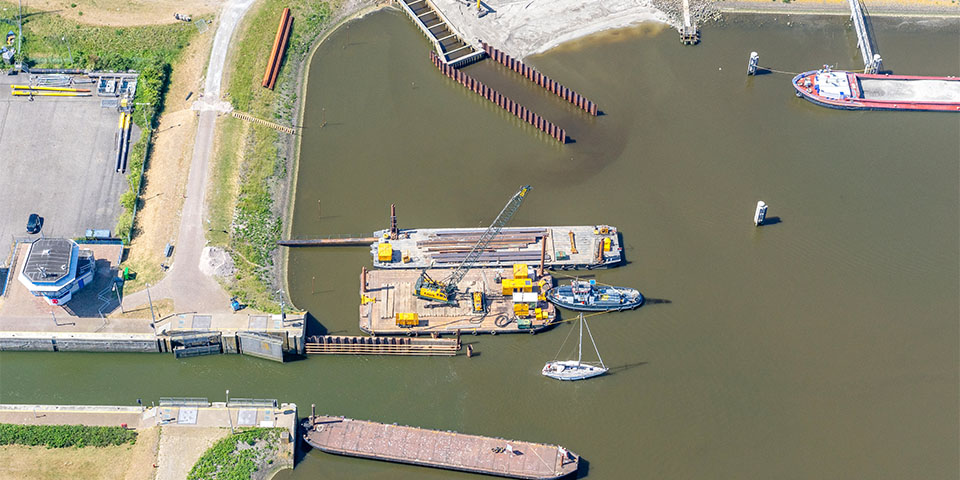
Aerial view of work on the floodgate at Den Oever.
The floodgate at Kornwerderzand
The floodgate at Kornwerderzand will be constructed on the Wadden Sea side of the bridges. In Kornwerderzand, a roller door will be used, made of steel profiles and plates and hydraulically driven by winches and cables. Bentlage explains, "A roller door was chosen because of the width of the waterway. This roller door weighs no less than 900,000 kg, measures 56 meters wide and 12 meters high, and is slid shut at very high water levels. Thus, the lock and the hinterland are protected from the force of the water, for the same reasons as at the floodgate in Den Oever. The concrete rail beam elements for the concrete roller conveyor will be produced elsewhere and hung as precast elements using a floating derrick. With this method, we will significantly reduce the construction time and allow ships to pass through sooner. The concrete mixture for the elements has also been well thought out; it is high-strength concrete and completely composed with an eye to the heavy load that must roll over the concrete track. A long service life of the structure is therefore guaranteed. Another time-saving measure is the use of precast concrete aprons on the water side of the final sheet piles. Later, the sheet piles are poured with concrete."
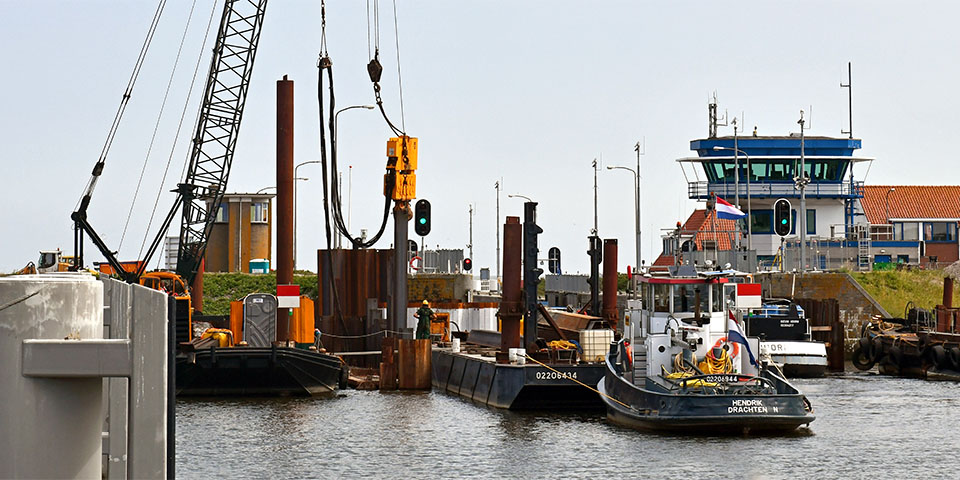
Construction of the floodgate at Den Oever
Working innovatively and sustainably
Innovative, sustainable and ecologically responsible work is being done by Levvel in all areas. As an example, Wijnants mentions the temporary flood barrier needed for the construction of the passage of the dike (coupure) at the Vismigration Pier. This is constructed of Levvel blocks. "When the temporary flood barrier has fulfilled its function, we move the Levvel-blocs to their final place on the dike. Another innovation is the concrete roller track provided at the floodgate at Kornwerderzand. Normally, roller gates run on steel rails. However, these are sensitive to deformation and maintenance. In this respect, concrete is much more durable and it ensures a longer life of the floodgate. Applying a concrete roller track for the roller door is definitely a new phenomenon."
In view of ecology
In conclusion, Wijnants and Bentlage explain how carefully the ecology around the Afsluitdijk is being handled. "Levvel went a step further by deploying an ecological team at both floodgate locations, which carried out an assessment per location of the impact of the floodgates on the flora and fauna present. The final conclusion is favorable: both floodgates have little to no impact on the surrounding ecology."
